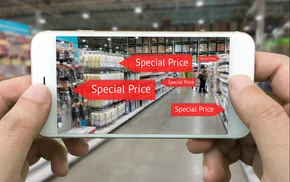Marketing is the core of what makes a modern retailer successful. It helps businesses expand their reach, connect with new customers, nurture existing relationships, and unfurl their brand story. It can help them stand apart from their competitors and create a unique value proposition. However, effective retail marketing isn’t easy. It requires a deep understanding of customer behaviour, market trends, and the broader competitive landscape. Retailers must know how to segment their target audience, create high-impact personalised messaging, and optimise their product assortment, pricing, and distribution to meet the ever-changing needs and preferences of their customer base. Fortunately, effective marketing is not just a luxury for major businesses with seemingly endless budgets. There is no shortage of marketing approaches and strategies to help retailers of all sizes reach their target audience — regardless of budget, experience, or time in the market.
Welcome to retail marketing of tomorrow

As retailers step into the future, they must envision and embrace new, innovative marketing methods that will allow them to thrive in an increasingly crowded retail landscape.
Neuromarketing: mind over matter
Did you know that many people choose a brand because of its purported self-expressive value? A famous Duke University study once revealed that people become more creative when given even the briefest exposure to the Apple logo than when exposed to the IBM logo. Because we commonly associate a brand with certain traits and ideas about ourselves, we are intrinsically drawn to certain ones over others. Marketers can harness this to their advantage — and this is called ‘neuromarketing’. As it turns out, we relate to brands much in the same way that we do to people. We empathise and relate to them, and sometimes, we even turn them into role models. Neuromarketing exploits this tendency by matching the company brand and its product offerings more closely to its target audience; identifying their deepest hopes, desires, and self-conceptions and reflecting them back in their brand image. In this sense, retailers can influence customers’ purchasing decisions and continue to do so long past the point of sale. Neuromarketing is expected to be increasingly used in the future of retail, and retailers that use this technology effectively can expect to reap significant benefits.

How social media changes the marketing game
Social media is increasingly taking centre stage in marketing, too. From influencers promoting retail products to brands establishing a presence of their own, the sky is seemingly the limit. As social media platforms are used near-universally by today’s millennial and Gen Z customer bases, they enable unprecedented opportunities to establish brand relationships and generate new leads. A great social media presence, in this day and age, is far more likely to draw in these younger demographics than traditional methods, such as purchasing advertising slots on television, or space in a magazine — not to mention, it’s more affordable too. Social media marketing can even be personalised at the individual level through behavioural event-driven marketing, which leverages real-time data and triggers to provide customers what they want with zero wait. The limits of social media marketing are, in fact, always being pushed further, with the emergence of extended reality technologies like augmented reality (AR) and virtual reality (VR) creating new, hyper-immersive opportunities for people to engage with brands they are interested in. Everybody has a device in their hands these days, and most of us are using social media too, so retailers can’t afford to miss out.
One great example of a renowned brand successfully harnessing social media is Sunglass Hut. The company launched its ‘Every Shade of You’ campaign for Snapchat users. The campaign focuses on celebrating diversity and individuality by allowing users to virtually try on different shades and share their unique style on the platform. Using the power of the platform’s Dynamic Catalogue and Shoppable AR, users can scroll through a vast selection of sunglasses, virtually try them on, and then purchase within the app. Users can create personalised content that they can share with friends and followers, generating buzz around the brand and increasing engagement. The use of augmented reality (AR) technology in the campaign provides an immersive, interactive, and fun experience for Snapchatters that keeps them on the platform for longer. The ‘Every Shade of You’ campaign also aligns with current social and cultural movements around individuality and diversity, making it a relatable and relevant campaign for Snapchatters. By embracing different styles and identities, Sunglass Hut is seen as a brand that celebrates and supports its customers. Overall, the campaign provides a unique and engaging experience for Snapchatters, strengthening brand awareness and loyalty.

Digital marketing magic: the crucial role of creativity
Something that many of the most effective marketing campaigns in history all have in common is boldness and creativity. Retail presents endless opportunities to experiment — and the retail store is a love laboratory. Consider how Mattel Games surprised shoppers in Canada with an unexpected game. At first, it looks like a regular poster — but on further inspection, it’s actually Pictionary — complete with challenges and unexpected prizes. By thrilling and delighting customers in an unexpected way, the brand was able to make an impact that’s not easily forgotten. After all, many retail customers tend to buy things based on emotions. This creative approach goes deeper still, however. Consider how Microsoft has harnessed eye-tracking techniques to learn more about how their clients engage with marketing materials in order to better engage them. Carrefour has been using this technology to enhance their product displays and make them more impactful for customers.
With digital marketing being the standard these days, retailers can no longer get away with putting in a standard effort. You need to find what makes your brand uniquely and emotionally appealing to customers. Kellogg’s is making efforts to level up its online advertising campaigns through the use of emotion recognition technology. Here’s how it works: an audience is presented with several different versions of an online advertisement and their emotional responses are captured via facial recognition technology. The technology can then distinguish between the responses, highlighting which advertisements had the most impact, and which ones retained their impact after repeated viewings. This data analysis technique reveals to marketers which approaches work best for garnering a lasting response, and convincing customers to make a purchase. Crucially, it also provides an opportunity to learn which approaches do not work — allowing for changes to be made if necessary.
Reaching the next level
Meeting the needs of the present is great, but the trends set to shape the future of retail are equally important. The use of augmented reality (AR) in retail is increasing all the time. The popular Asian dairy brand Dutch Lady, for instance, uses the technology to create entertaining, child-friendly advertising. Using the company’s dedicated app, young customers can point their devices towards any Dutch Lady dairy product to generate a pop-up animation of the company mascot Matt and his cow Bell at their farm in Holland. The pair will then begin to talk about the product, allowing for pictures to be taken, and present collectible bonus toys which can then be attained in real life. Another technology which cannot be missed is AI. Many people’s first associations with AI are of automated workplace tools or perhaps fitness tracking apps. Its uses are, however, becoming increasingly creative. Can you believe there are even AI-generated influencers these days? Lil Miquela is one such influencer. She uses a chatbot to make fashion suggestions to her audience of millions and has collaborated with several well-known brands such as Calvin Klein, Prada, Samsung, and UGG. She has also worked with famous musicians and artists like Zara Larsson, Tame Impala, and Calvin Harris for various projects, including music videos and merchandise. People don’t seem to mind that the interaction isn’t technically ‘real’ — and nor do her sponsors, who pay her substantially for being included in her recommendations.

In closing
In today’s ever-changing retail landscape, marketers can’t allow themselves to become too comfortable. There are countless ways to engage customers these days, and some — like AI or social media — are only going to grow in importance. A traditional approach may, at present, ensure a predictable return, but as time goes by, these returns will likely diminish and a new approach will become necessary. Those retailers who already embrace the innovative marketing techniques of tomorrow will be the ones best prepared to thrive in the future, as they will have the experience and the presence within these new spaces to provide an essential advantage. Being prepared means experimenting and accepting a little bit of risk, but the upside is becoming future-proof and driving the business towards new levels of success.


